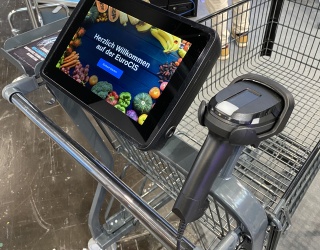
More than ever, today’s interior design industry has a tough time to attract customers to stores. In this interview, Sven-Hendrik Timmermann, Chief Digital Officer at JAB Josef Anstoetz KG, explains how the textile and fabric outfitter uses digital services to help both retail partners and end users to enter a new era of increased transparency and information.
Mr. Timmermann, what has JAB Anstoetz accomplished so far?
Our goal is to significantly improve the digital findability and experience of our products and our dealers. Our starting point was the product finder, which currently makes two-thirds of our product choices available online and is linked to a dealer search.
We have also created search engine optimized microsites for a selection of retailers featuring their product portfolios and contact information. To overcome reservations about brick-and-mortar stores and give end consumers pricing orientation, we launched an online configurator for draperies and curtains last year and suggest readily configured window treatments featured in real room layouts to inspire customers. Online purchase is possible through our retailers and is carried out via a web shop, which we make available to selected retailers in return for a share of expenses.
How is the user acceptance?
The number of users shows great promise and thanks to feedback from our dealers we know that this has actually created a new funnel in the customer journey. Customers plan window treatments online from the comfort of their home to get an idea about the cost and then buy the items at the store, possibly after seeking additional consultation. Research online, purchase offline has thus also edged its way into the world of fabrics.

You have just launched your latest option: You run Google ads for your dealers. What would you like to achieve by doing so?
The individual Google AdWords ads link to the JAB microsites to increase the findability of dealers in their respective local vicinity. They are an important part of our online marketing strategy.
How do you create the contents of the dealer microsites?
It’s far less time-consuming than one might think at first. For the most part, we already have corresponding material available since we have maintained marketing partnerships with and for our clients for many years. We request information that’s not yet available and update it, which generally happens very quickly and easily.
You also provide digital services to the dealers. Please tell us about your “Digital Sewing Studio“.
We have been providing services for our dealers for some time. Examples of this are our JAB marketing portal, a Web2Print portal that enables our customers to personalize their advertising material or the JAB Customer Center, allowing dealers to order fabrics, wallpapers, and swatches or to reserve items. The JAB Online Studio is our latest development that went live in January. Now, interior designers can also enter custom sewing orders online.
What are the benefits?
There are many advantages. Now, interior designers not only have online access to real-time availabilities and pricing information, but the order processing is also drastically sped up thanks to the direct data transfer. Errors or follow-up questions are eliminated thanks to the plausibility checks performed during the entry process.
The B2C and B2B sectors seem to draw nearer in terms of online and offline choices. What can they learn from each other?
I think B2B is increasingly converging with B2C. Over the past years, B2C eCommerce has definitely already done some pioneering work and defined standards that also do well in the B2B environment and are now also picked up by this target audience thanks to the private lives of B2B users. I think the most significant learning experience for B2B is the consistent focus on customer needs combined with a strong emphasis on user experience.
Having said that, the current B2B environment – strongly influenced by B2C – has increased expectations of its own environment. This includes an appealing, interactive and highly personalized responsive website design, online delivery information or ship notification emails, relevant content integration that goes beyond mere product description, as well as active social media communication.
The personal connection with customers should not fall by the wayside due to digitization. How do you bolster this core aspect?
We see digitization in a bridge builder role at this juncture and use the new communication opportunities that result from digitization as a chance to build and strengthen the personal connection with customers. Surely the best example of this is our recently introduced online chat function. Yet other techniques such as contact forms and the currently tested online scheduling setting (for end users to schedule appointments with our dealers through their microsites) don’t intend to curtail personal connections but are designed to create personal connections that might not have been developed in the past.









